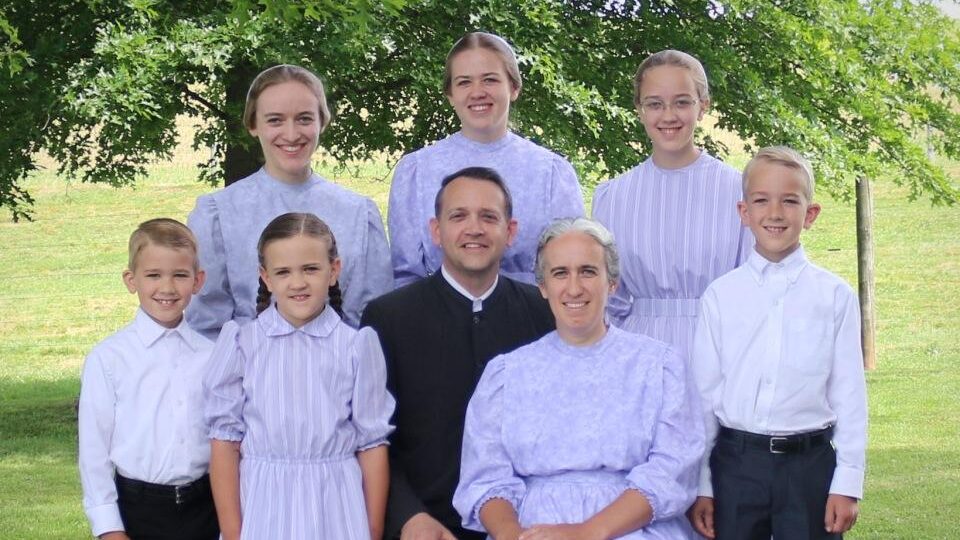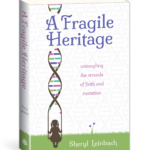A Fragile Heritage: Untangling the Strands of Faith and Mutation
by Sheryl Leinbach
The following excerpts are taken from A Fragile Heritage by Sheryl Leinbach. It is one family’s story woven with MSUD stories from the past to give an overview of how outcomes have changed.
©2023 Christian Light Publications, Inc. All rights reserved. Used by permission.

Excerpt from Chapter 3, A Flawed Heritage
Early Thursday morning, the phone rang in Louisa’s hospital room. I found relief in hearing Wesley’s voice even though it dripped with anxiety. “Is Louisa okay? How was your night?”
I wished I could be optimistic, but I had to say I couldn’t see any improvement. “You need to get here! I don’t think the doctors know what is going on.”
Before ending the call, Wesley hesitated. “Your mom called and said someone asked about the possibility of maple syrup urine disease being in the family. The symptoms reminded her of that.”
That sweet diaper! Oh! I hadn’t even mentioned it to Wesley. “We don’t have any relatives with that,” I said quickly.
Wesley’s voice came through the phone line clearly. “Your mom said her mom’s cousins have children with it. Ask the doctor. I know … it’s unlikely.”
I dropped the phone in its place and thought, Yeah, the brother-in-law’s uncle’s wife’s … But after all, we were desperate. So I mentioned it to the student nurse who was in the room at the time.
Another nurse brought me supplies so I could bathe Louisa. Despite my weariness it gave me a sense of doing something. I rubbed the washcloth over her sweet features, but I couldn’t wash away the creases of distress on her forehead or the tight pinch of her lips. Without seeing my own face, I knew it mirrored hers, and I couldn’t wash away the feeling that something terrible lurked just around the corner.
I sank gratefully into the bedside rocking chair as the nurse arranged the IV pole so I could hold Louisa while I waited for Wesley. Her eyes stayed closed and unresponsive, yet through my own closed eyelids I felt hope flicker with her every soft breath. Something could change; she could still be okay.
Dr. Williams hurried into the room. “We just got some test results. May I let some of the staff in to listen to this conversation?” I knew two things about Dr. Williams by now: he was the head pediatric doctor, and his voice vibrated at about two octaves lower than my husband’s tenor.
As about ten white-coats filed in, I desperately wished Wesley would be with me. This had to be serious! I shivered, pressing the warmth of my baby against me, pleading along with the mothers of all sick babies—Let it be something that can be fixed!
The doctor hadn’t said more than a few words when Wesley walked in. I could read the alarm in his face as he took in the full room. Somehow he got through the wall of people and dropped on one knee to feel Louisa’s warm face and tilted his head to listen to her breathing.
I saw a look of compassion spread through the group. I smiled at them—This is my baby’s daddy; let the words be gentle.
Dr. Williams faltered, trying to retrace the words he had begun with, and for a few seconds I saw him wish he didn’t have to say them. “The Pennsylvania newborn screening personnel just contacted the hospital. The test for maple syrup urine disease, known as MSUD, has shown positive. I was literally on the line trying to track down Louisa’s newborn screening results, because of the concern you passed to the nurse, when the call came through.”
He said the words maple syrup urine disease slowly, his deep, deep tone appropriate for the heavy words, sinking them into our exposed hearts. Only four words, but they carried enough weight to extinguish my hopes.
This won’t be fixed. It’s genetic. This wouldn’t be a lived-happily-ever-after story, following two sick days in Hershey. . . .
Excerpt from Chapter 5, Sitting with Our Fears
Still in the hospital room, Dr. Morton swabbed Louisa’s ear with a cotton swab, accumulating a bit of wax. “Here, smell this.” The cotton swab passed from hand to hand around the room.
“It smells sweet—just like maple syrup,” Wesley said.
Heads nodded.
“No fancy tests needed.” Dr. Morton’s eyes twinkled behind his wire-rimmed spectacles. “Take a wet diaper from a sick MSUD baby like this, and let it dry. The strong maple-syrup smell is unmistakable.
“Dr. John Menkes first described maple syrup urine disease in a 1954 pediatric journal. The peculiar sweet odor of the urine gave the disease its name. Want to guess where Dr. Menkes was from?” Dr. Morton’s sleepy face spread into a wide twinkle. “New England. A doctor from anywhere else would have called it pancake syrup or burnt sugar urine disease. We have difficulty explaining the name to folks from other countries who have never heard of maple syrup.”
“What makes the sweet smell?” It was not surprising Mom would ask. If there were genes for the love of explanations, Wesley had inherited them from her.
“Well …” Dr. Morton stroked Louisa’s hair, and even his body language twinkled. “So you want to know why she smells sweet. She can have all the maple syrup she ever wants, by the way. The simplest way to tell you is that since her body does not metabolize or break down protein in the normal way, keto acids are excreted in large amounts in the urine.”
“What makes her unable to metabolize protein?” Wesley chose to use the word metabolize in his question rather than the simpler one Dr. Morton had offered. Dr. Morton took the cue that Wesley was not afraid of bigger words.
“All proteins are a combination of twenty different amino acids.”
I watched Wesley nod. If I learned that in school, I had forgotten.
“Every cell in her body”—Dr. Morton gestured to indicate Louisa—“is unable to produce the enzyme necessary to metabolize three of those twenty amino acids. We call those three amino acids the branched-chain amino acids. They are leucine, isoleucine, and valine.”
Greek, French, and Latin.
But Wesley held up his hand before Dr. Morton could continue. “Let me repeat those—leucine, isoleucine, and valine—the three amino acids she can’t metabolize. I want to remember them.”
“You’ll remember them all right. Everyday language for MSUD. We’ll keep those three amino acids as close to normal as possible. Your body does this for you, but we’ll have to do it for Louisa.”
Dr. Morton took up the hairbrush lying next to Louisa and brushed her hair carefully. Though everyone in the room noticed this unexpected gesture, he seemed comfortable and unaware. “The future is brighter than it has ever been for these children.” He rumpled the curls above his ear, and I noticed warm red undertones softened with white. “The last fifteen years gave me some white hair, but the future is bright.
“In the early days”—Dr. Morton still held the brush—“doctors did what seemed the most sensible thing. They completely removed those three amino acids from the diet. The only way to do that was to remove all foods containing protein, because protein foods contain all twenty amino acids. They developed a synthetic formula providing the other seventeen amino acids. But they overlooked the fact that those three amino acids are essential amino acids. A child needs protein—all twenty amino acids—to grow new tissue, muscle, skin, hair, everything.” He gestured toward her hair and seemed to realize for the first time what was in his hand. He laid the brush carefully along the top edge of the mattress. . . .
Excerpt from Chapter 8, And Then There Was Dr. Strauss
“Do we still need to wake Louisa every three hours to feed her? I think she’d sleep a six-hour stretch at night if we’d let her.”
Dr. Strauss lifted Louisa off the exam table and held her in the air, testing her ability to hold her head. “I can’t let you do that.” He chuckled in two syllables. “I see you smiling about that, you sweetie. You like to see Mom’s face in the middle of the night. We can’t tell her to stop that, can we?” He handed her to me. “She’s advanced. Her eyes follow me when I talk to her, and she smiles at all the right places. She isn’t just doing well, she is …”
I remember this conversation because I needed that confirmation to balance my regret at her late diagnosis. But I remember it more because Dr. Strauss described her using a word I had never heard before. I let my tongue roll it, savor it, while Dr. Strauss explained that it meant beyond expectation, the cream top of excellence, perhaps something to do with her instant response. When I got home I pulled out the dictionary to find it, but it wasn’t there. I tried every spelling, until I wasn’t sure if I had somehow twisted the word in my memory. I lost it. And it still grieves me. I like new words.
Dr. Strauss played this word trick on me nearly every visit after. He would use a word new to me, and when I got home I thought I remembered it, but could not find it in my dictionary. Even my husband’s five-inch-thick dictionary failed me.
But here on my first visit with him I only knew he hadn’t yet answered my first question; his eyes said so. “Can we gradually lengthen the time between night feedings? I dislike setting my alarm for feedings. She won’t have to drink formula every three hours for the rest of her life, will she?”
Dr. Strauss leaned forward in his chair. “Let’s talk about anabolism and catabolism. Anabolism is the constructive process of body metabolism—the building up of tissue—while catabolism is the destructive process of the physical and chemical changes continually taking place within the body—the breaking down of tissue.”
“They’re opposites.” Wesley’s response indicated he was following the explanation.
“Yes, anabolism is essentially the growth process where new cells such as skin, muscle, and hair are being built. Catabolism is the opposite where—because protein is not available—the body begins breaking down stored protein.” He grinned as if he loved nothing better than to teach parents. He did not pause. He wasn’t trying to decide how much of this explanation we could handle. He knew our ability to understand any medical term depended on his ability to explain it.
“A baby cannot go as long as you or me between meals without becoming catabolic. The MSUD formula provides enough protein to grow muscle, skin, everything, but when an MSUD patient goes too long between feedings, she becomes catabolic and begins breaking down stored protein.” Dr. Strauss still didn’t pause.
“That stored protein contains leucine. Because she cannot metabolize leucine in the normal way, a long period between feedings will make her leucine level go up. Our goal is to feed her regularly enough so her body maintains an anabolic state of growing and building new tissue. MSUD is complicated and requires us to pay the strictest vigilance to these details. Our understanding of catabolism in MSUD patients enables us to manage MSUD in a way that will protect Louisa from the damage the children in the early years had.” . . .
Excerpt from Chapter 16, Swords and Brooms
My feet slogged heavily in the mire of unknowns. So this was MSUD? We could not know which extra bounce of the ponytails at two in the morning meant we should speed to the hospital and which meant she was fine. All the confidence built up by our previous experience of being able to guess her levels had shattered.
I kept trying to reorder the events in my mind: calling the clinic sooner, heading straight at the crossroad instead of turning left. Making her drink more, lots more. Donna had seemed to suggest something about trying harder. Could we have done it at home? How did other MSUD parents get a vomiting child to drink two ounces of formula an hour? Our friends and our family had no MSUD, no answers, no experience.
At our next clinic checkup I voiced my questions. . . .
“I keep reliving those attempts to get formula into Louisa, and the way we concluded her leucine must not be that high because she wasn’t ataxic or hallucinating. I wish we had come down to the clinic sooner.”
“No, no,” Dr. Strauss broke in. “Don’t go there. She wasn’t hospitalized because of a mistake you made, Sheryl. She was hospitalized because of the nature of MSUD. MSUD is unpredictable and at times difficult to control. We are humbled by the disease.”
. . . “I want to be able to control MSUD,” I said quickly, in case he couldn’t tell.
“The kind of MSUD control you are talking about isn’t possible with dietary management. I can’t give you a formula recipe that will absolutely keep her leucine from going up when she gets sick. The only way to remove the risks of acute metabolic decompensation is—” Dr. Strauss always leaned forward in his chair, but he leaned forward farther, looking me full in the face as if to drive his words directly into my seeking brain.
I couldn’t shift my gaze; I must not misunderstand this.
“—liver transplant.” He waited a bit for the words to penetrate. I knew acute metabolic decompensation was his fancy way of saying what had just happened when Louisa got sick. But liver transplant had no fancy term to mask the blunt reality.
“Our first MSUD patient to undergo liver transplant, back in 1997, has had an exceptional long-term outcome.” He launched into thick medical jargon, and though I did not know it at the time, I would not have found it hard to believe he was in the middle of writing a medical journal article on the subject.1
He broke down the jargon for me sentence by sentence, and I took home one new word—homeostasis. It means equilibrium and balance, something a new liver could do for my MSUD child, controlling amino acid levels perfectly no matter what diet she ate, no matter if she got a virus. All without daily worry about formula intake or constant checking of amino acid levels. Homeostasis meant MSUD would no longer endanger my child’s brain.
“This is the kind of control you are asking for, Sheryl. There is no other way but liver transplant to accomplish this. We now have data from ten elective liver transplants done by Children’s Hospital of Pittsburgh since June 2004. All these patients have experienced normalization of amino acid levels within six to twelve hours of transplant and remained so on unrestricted protein intake—eating burgers and milkshakes.” He winked at Louisa, who had never tasted either.
I stumbled on the way out to my vehicle. I was carrying a case of formula, balancing on it a few papers, a sippy cup, and my purse, while directing Louisa’s steps. It was a load.
But the bigger load was invisible. Liver transplant. I staggered under it. I still couldn’t remember the color of Dr. Strauss’s eyes, no matter how many times I’d sat fascinated by them. But the message they held had been clear, potent. He understood the load we carried.
“Like living under the sword of Damocles,” Dr. Strauss had said. “MSUD is just that frightening.” The comment was lost on me until he explained that this was an ancient story of a Sicilian emperor who called for a banquet and seated Damocles under a sword suspended by a single hair. Today the phrase meant a situation that threatened devastation at any moment.
A heavy load. A dangling sword. Somewhere, God.
Liver transplant could not be done at the friendly Lancaster General Hospital. We would have to live in the city of Pittsburgh, over four hours from home, for the duration of her recovery. A month, perhaps two. That alone would be a daunting step for country folks like us.
Back home I detoured the liver transplant subject but discussed MSUD illness with Wesley over the supper table. “Aren’t we wrong to feel so stressed when Louisa gets sick? . . .”
“I think it’s our own responsibility that frightens us,” Wesley said, tickling Louisa’s bare foot when she nudged him with it. “We have to decide when to call the clinic according to the clues we have. Sometimes those clues aren’t clear, and we choose to wait in hopes that she may not be seriously ill. Yet we fear getting to the hospital too late.”
Dr. Strauss had said Louisa’s hospitalization wasn’t due to a mistake we had made. He had chosen the word knowing mistakes were a parent’s biggest fear. But we were human. We would make mistakes. Even the best doctors couldn’t compensate for our misjudgment. Even our all-knowing God wasn’t known to write in bold lettering on the wall what we should do next. . . .
Order your copy of A Fragile Heritage from the publisher:

